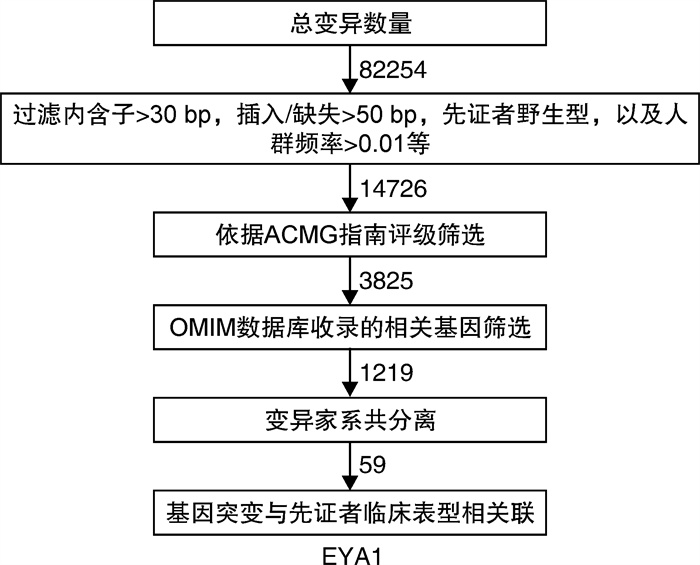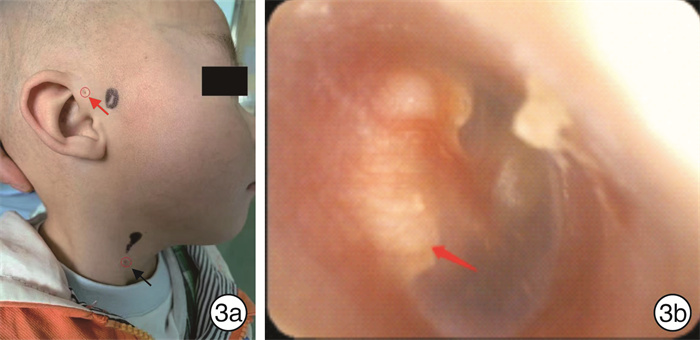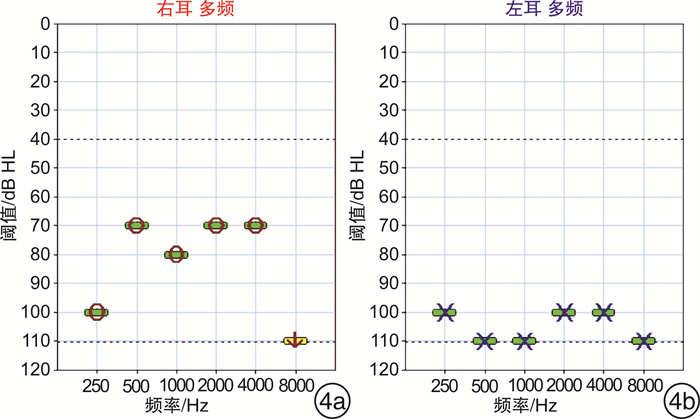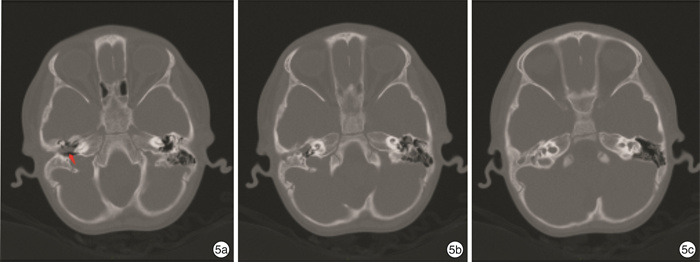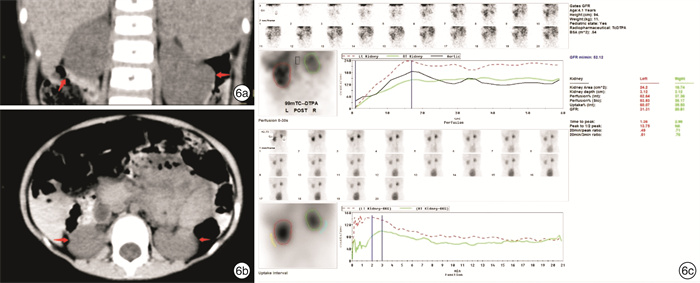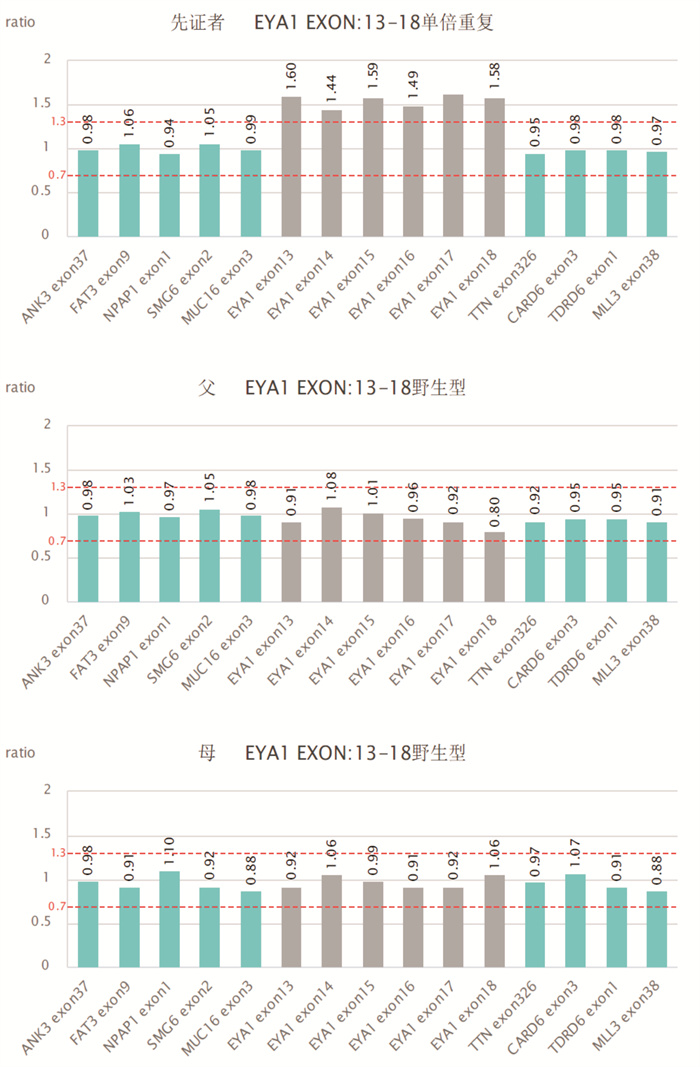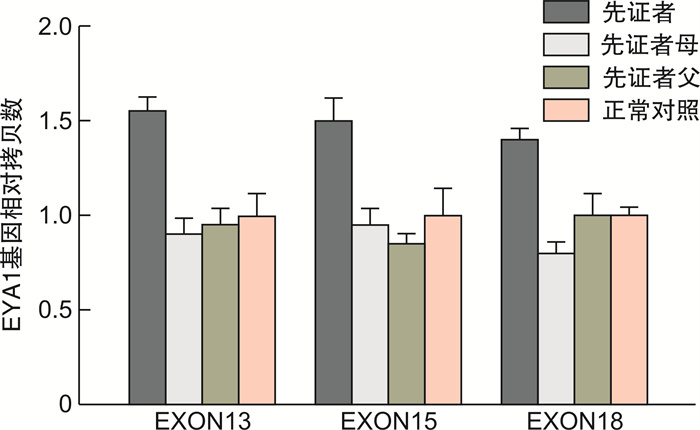Novel duplication mutation of EYA1 causes branchio-oto-renal syndrome in a Chinese family
-
摘要: 目的 为一临床诊断为鳃-耳-肾综合征的中国家系寻找致病基因及位点。 方法 回顾性分析1个鳃-耳-肾综合征核心家系的临床特征及治疗经过;应用全外显子测序技术(WES)对先证者进行全外显子水平突变分析,其中部分外显子缺失/重复利用荧光定量PCR方法(Realtime-PCR)验证。 结果 该家系中先证者,男,4岁1个月,有耳聋、内耳和中耳结构畸形、耳前瘘管、鳃裂瘘管和肾萎缩临床表型,符合鳃-耳-肾综合征的临床诊断,父、母均无类似表型。WES检测及荧光定量PCR验证发现患者EYA1基因外显子13~18存在单倍重复,其父母未见异常。外科手术切除双侧耳前及鳃裂瘘管,术后恢复较好,佩戴助听器辅助听力。 结论 本研究寻找到一种新的EYA1 基因外显子重复变异致鳃-耳-肾综合征,拓展了EYA1 基因的突变谱。Abstract: Objective To identify novel genetic causes of branchio-oto-renal (BOR) syndrome in a Chinese family. Methods Clinical characteristics and treatment of a family with a BOR syndrome were retrospectively analyzed. Genetic analysis was conducted by trio whole exome sequencing (WES) and the duplicated exons were verified by fluorescence quantitative PCR (real-time PCR). Results In this family, the affected individual had deafness, structural malformation of inner ear and middle ear, pre-auricular fistula, cervical fistula and renal atrophy consistent with the clinical diagnosis of BOR syndrome. Neither the father nor the mother had similar phenotype. WES and quantitative fluorescent PCR revealed that the patient had a de novo partial duplication involving exons 13 to 18 of EYA1 gene. This mutation has not been reported in literature or any database. Bilateral pre-auricular fistulas and cervical fistulas were surgically removed and the surgery wound healed well, while hearing AIDS had been worn to assist hearing. Conclusion This study is the first to detect a novel de novo partial duplication (exons13-18) of EYA1 gene leading to BOR syndrome, and expands the mutant spectrum of EYA1 gene in Chinese population.
-
Key words:
- branchio-oto-renal syndrome /
- EYA1 gene /
- copy number variation
-

-
[1] Fraser FC, Sproule JR, Halal F.Frequency of the branchio-oto-renal(BOR)syndrome in children with profound hearing loss[J]. Am J Med Genet, 1980, 7(3):341-349. doi: 10.1002/ajmg.1320070316
[2] 孙淑萍, 卢伟, 朱丽雅, 等.鳃-耳-肾综合征误诊为耳前瘘管二例[J].中华耳鼻咽喉头颈外科杂志, 2014, 49(4):330-332. doi: 10.3760/cma.j.issn.1673-0860.2014.04.014
[3] 温莹莹, 孙宇, 孔维佳.重视基因诊断在鳃耳肾综合征中的应用[J].临床耳鼻咽喉头颈外科杂志, 2018, 32(16):1226-1231. https://www.cnki.com.cn/Article/CJFDTOTAL-LCEH201816005.htm
[4] Chang EH, Menezes M, Meyer NC, et al.Branchio-oto-renal syndrome:the mutation spectrum in EYA1 and its phenotypic consequences[J]. Hum Mutat, 2004, 23(6):582-589. doi: 10.1002/humu.20048
[5] Abdelhak S, Kalatzis V, Heilig R, et al.Clustering of mutations responsible for branchio-oto-renal(BOR)syndrome in the eyes absent homologous region(eyaHR)of EYA1[J]. Hum Mol Genet, 1997, 6(13):2247-2255. doi: 10.1093/hmg/6.13.2247
[6] Castiglioni A, Melchionda S, Carella M, et al.EYA-1-related disorders:Two clinical cases and a literature review[J]. Int J Pediatr Otorhinolaryngol, 2014, 78(8):1201-1210. doi: 10.1016/j.ijporl.2014.03.032
[7] Gigante M, d'Altilia M, Montemurno E, et al.Branchio-Oto-Renal Syndrome(BOR)associated with focal glomerulosclerosis in a patient with a novel EYA1 splice site mutation[J]. BMC Nephrol, 2013, 14:60-60. doi: 10.1186/1471-2369-14-60
[8] Men M, Li W, Chen H, et al.Identification of a Novel CNV at 8q13 in a Family With Branchio-Oto-Renal Syndrome and Epilepsy[J]. Laryngoscope, 2020,130(2):526-532. doi: 10.1002/lary.27941
[9] Chen P, Liu H, Lin Y, et al.EYA1 mutations leads to Branchio-Oto syndrome in two Chinese Han deaf families[J]. Int J Pediatr Otorhinolaryngol, 2019,123:141-145. doi: 10.1016/j.ijporl.2019.05.006
[10] Wang YG, Sun SP, Qiu YL, et al.A novel mutation in EYA1 in a Chinese family with Branchio-oto-renal syndrome[J]. BMC Med Genet, 2018, 19(1):139. doi: 10.1186/s12881-018-0653-2
[11] Wang SH, Wu CC, Lu YC, et al.Mutation screening of the EYA1, SIX1, and SIX5 genes in an East Asian cohort with branchio-oto-renal syndrome[J]. Laryngoscope, 2012,122(5):1130-1136. doi: 10.1002/lary.23217
[12] 李隽, 王智楠, 黄芳, 等.0~6岁正常儿童骨导听性脑干反应的特征分析[J].听力学及言语疾病杂志, 2011, 19(2):123-125. doi: 10.3969/j.issn.1006-7299.2011.02.011
[13] 刘梦婷, 张天虹.综合征性耳聋的诊断与治疗略[J].临床耳鼻咽喉头颈外科杂志, 2021, 35(3):285-288. https://www.cnki.com.cn/Article/CJFDTOTAL-LCEH202103023.htm
[14] Abdelhak S, Kalatzis V, Heilig R, et al.A human homologue of the Drosophila eyes absent gene underlies branchio-oto-renal(BOR)syndrome and identifies a novel gene family[J]. Nat Genet, 1997, 15(2):157:164.
[15] Zou D, Silvius D, Fritzsch B, et al.Eya1 and Six1 are essential for early steps of sensory neurogenesis in mammalian cranial placodes[J]. Development, 2004,131(22):5561-5572. doi: 10.1242/dev.01437
[16] Ruf RG, Xu PX, Silvius D, et al.SIX1 mutations cause branchio-oto-renal syndrome by disruption of EYA1-SIX1-DNA complexes[J]. Proc Natl Acad Sci U S A, 2004,101(21):8090-8095. doi: 10.1073/pnas.0308475101
[17] Xu PX, Cheng J, Epstein JA, et al.Mouse Eya genes are expressed during limb tendon development and encode a transcriptional activation function[J]. Proc Natl Acad Sci U S A, 1997, 94(22):11974-11979. doi: 10.1073/pnas.94.22.11974
[18] Li X, Oghi KA, Zhang J, et al.Eya protein phosphatase activity regulates Six1-Dach-Eya transcriptional effects in mammalian organogenesis[J]. Nature, 2003,426(6964):247-254. doi: 10.1038/nature02083
[19] Buller C, Xu X, Marquis V, et al.Molecular effects of Eya1 domain mutations causing organ defects in BOR syndrome[J]. Hum Mol Genet, 2001, 10(24):2775-2781. doi: 10.1093/hmg/10.24.2775
[20] Musharraf A, Kruspe D, Tomasch J, et al.BOR-syndrome-associated Eya1 mutations lead to enhanced proteasomal degradation of Eya1 protein[J]. PLoS One, 2014, 9(1):e87407. doi: 10.1371/journal.pone.0087407
[21] Brophy PD, Alasti F, Darbro BW, et al.Genome-wide copy number variation analysis of a Branchio-oto-renal syndrome cohort identifies a recombination hotspot and implicates new candidate genes[J]. Hum Genet, 2013,132(12):1339-1350. doi: 10.1007/s00439-013-1338-8
[22] Dantas VG, Freitas EL, Della-Rosa VA, et al.Novel partial duplication of EYA1 causes branchiootic syndrome in a large Brazilian family[J]. Int J Audiol, 2015, 54(9):593-598. doi: 10.3109/14992027.2015.1030511
-




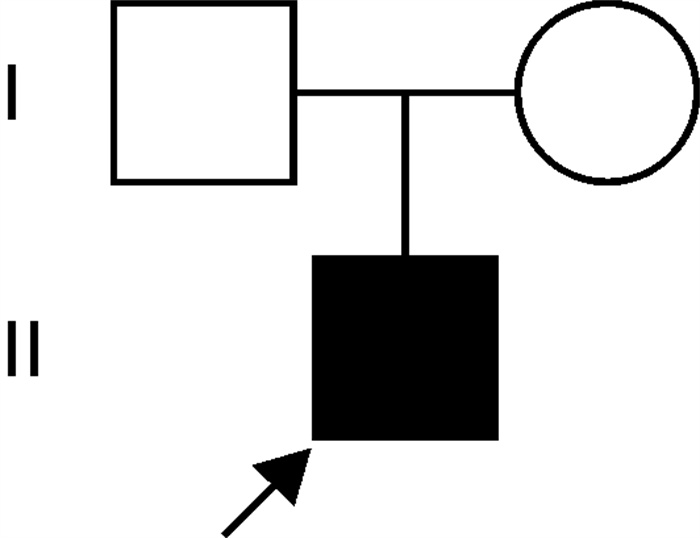
 下载:
下载:
